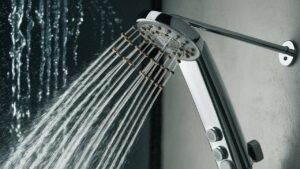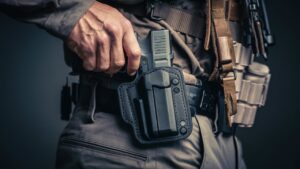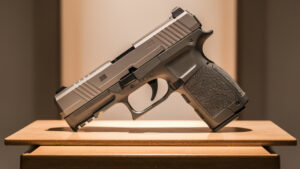For a successful small-game hunt, your scope settings can make all the difference. Proper eye relief and parallax adjustment can enhance your accuracy and comfort.
Understanding how to adjust these settings is essential for any hunter. Eye relief ensures you have a clear, full view through your scope without straining your eyes. Parallax adjustment corrects the perceived movement of the reticle when you shift your eye position, which is crucial for hitting small targets.
This guide will help you understand and optimize these settings. By the end, you’ll be better prepared for your next small-game hunting adventure. Ready to fine-tune your scope? Let’s dive in.
Importance Of Eye Relief
Proper eye relief ensures clear vision and reduces eye strain during small-game hunting. Adjusting scope settings optimizes accuracy and comfort.
When hunting small game, optimizing your scope settings is crucial. One key aspect is eye relief, which refers to the distance between your eye and the scope lens. The right eye relief enhances your comfort and safety and improves your field of view.
Comfort And Safety
Comfort and safety are paramount when using a scope. Proper eye relief ensures you won’t strain your eye while aiming.
A scope with too little eye relief can cause the scope to hit your face upon recoil, which can be both painful and dangerous. Imagine focusing on that elusive rabbit, only to get a painful knock from your scope.
An optimal eye relief setting allows for a relaxed posture. This makes it easier to stay focused and steady. Have you ever felt neck pain after a long hunting day? Correct eye relief can help reduce that strain.
Field Of View
Eye relief also significantly affects your field of view. The right distance lets you see a full, clear image through your scope. This helps you spot small game quickly and accurately.
Too much eye relief can create a narrow field of view, making it harder to track moving targets. On the other hand, too little eye relief can cause a “tunnel vision” effect, limiting your awareness of the surroundings.
Finding the sweet spot in eye relief can make all the difference. It can help you capture your target effectively and safely. Have you tested different settings to see what works best for you? It might be time to adjust and improve your small-game hunting success.
Practical Tips:
– Test your scope in various lighting conditions
– Adjust your eye relief with different shooting positions
– Note the recoil of your firearm and adjust accordingly
Remember, the right eye relief isn’t just about comfort. It’s about maximizing your hunting efficiency and safety. So next time you set up your scope, pay attention to this small but vital detail. Happy hunting!

Understanding Parallax
Parallax is a common issue in rifle scopes. It can affect your accuracy during small-game hunting. Understanding parallax is key to making precise shots. This section will explain parallax, its causes, and its impact on accuracy.
Definition And Causes
Parallax occurs when the target image and the reticle are not on the same focal plane. This means the reticle appears to move when you shift your eye position. Parallax can be caused by improper scope settings or a low-quality scope. It can also happen if the scope is not adjusted for the shooting distance.
Impact On Accuracy
Parallax can greatly affect your shot accuracy. If the reticle moves, it creates aiming errors. These errors are more noticeable at longer distances. For small-game hunting, even a small error can result in a missed shot. Adjusting the parallax setting on your scope is crucial. It ensures the reticle stays fixed on the target. This results in more accurate and consistent shots.
Setting Eye Relief
Setting the right eye relief is crucial for a successful hunt. Eye relief is the distance between your eye and the scope’s eyepiece. This distance allows you to see the full field of view without any dark rings around the image. Proper eye relief ensures comfort and safety.
Measuring Correct Distance
To measure the correct distance, mount the rifle on a stable surface. Hold the rifle as you would while hunting. Adjust your head to find the point where the image is clear and full. This is your eye relief distance.
Use a tape measure to note this distance. It is usually between 3 to 4 inches. This measurement is crucial for setting the scope correctly.
Adjusting Scope Position
Once you have your eye relief distance, adjust the scope position on the rifle. Loosen the scope rings and move the scope forward or backward. Align it to match your measured eye relief distance.
Tighten the scope rings once aligned. Ensure the scope is level. Check the eye relief again by shouldering the rifle. The image should be clear and comfortable.
Repeat the adjustments if needed. Proper scope position helps in quick target acquisition. It also prevents eye strain and enhances accuracy.
Adjusting Parallax
Adjusting parallax is vital for accurate small-game hunting. It ensures a clear target image. This adjustment corrects the perceived movement of the reticle on the target. It eliminates visual errors that can affect shot precision. Understanding parallax adjustment can make a big difference in your hunting success.
Identifying Parallax Error
First, identify parallax error. Look through your scope at the target. Move your head slightly side to side. Notice if the reticle appears to move. If it does, you have a parallax error. This movement can cause you to miss your shot. Correcting it is essential for accurate targeting.
Using Adjustment Knob
To fix parallax error, use the adjustment knob. Most scopes have this knob on the side or the objective lens. Turn the knob while looking through the scope. Focus on the target until the reticle stops moving. This means the parallax is adjusted correctly. Your target image will be clear and stable.
Optimal Scope Settings
Small-game hunting demands precision and accuracy. Optimal scope settings can make a significant difference. Properly adjusting eye relief and parallax can improve your aim. It can also enhance your overall hunting experience. Let’s dive into the details to help you get the best performance from your scope.
Balancing Eye Relief And Parallax
Eye relief refers to the distance between your eye and the scope. It is crucial for comfort and safety. A good eye relief setting keeps your eyebrow safe from recoil. Most scopes offer adjustable eye relief. Find a distance that allows a full field of view without straining your eye.
Parallax adjustment is equally important. Parallax occurs when the reticle appears to shift. This happens when you move your head slightly. It can throw off your aim. Many scopes come with a parallax adjustment knob. Use it to align the target and reticle at the same distance. This reduces aiming errors.
Testing In The Field
Field testing is vital for setting eye relief and parallax. Begin with a solid rest or bench. Adjust your eye relief until you see a clear image. Ensure you have a full field of view. Next, move on to parallax adjustment. Focus on a target at your typical shooting distance. Adjust the parallax knob until the reticle stays fixed when you move your head slightly.
Practice with different targets and distances. This helps fine-tune your settings. Consistent testing can lead to improved accuracy. It also builds confidence in your equipment. Remember, the best settings may vary based on individual preferences.
Factors Affecting Scope Performance
When it comes to small-game hunting, having the right scope settings can make all the difference. Two critical elements to get right are eye relief and parallax adjustment. These factors can significantly impact your accuracy and overall hunting experience. Let’s dive into the key factors affecting scope performance.
Magnification Levels
Choosing the right magnification level is essential. Higher magnification can bring distant targets into clear view but can also make it harder to steady your aim. Lower magnification levels offer a broader field of view, allowing you to track moving targets more effectively.
Think about your typical hunting environment. If you’re often in dense woods, a lower magnification might suit you better. On the other hand, open fields may require higher magnification to spot and target small game.
Experiment with different magnification settings during practice sessions. This way, you can find what works best for your needs. Remember, higher isn’t always better—balance is key.
Environmental Conditions
Environmental factors can greatly affect scope performance. Weather conditions like fog, rain, and sunlight can impact visibility and focus. Ensure your scope has weather-resistant features to maintain clarity in various conditions.
Consider the time of day you usually hunt. Low-light conditions at dawn or dusk require scopes with good light transmission. This feature helps in gathering enough light to maintain a clear image.
Another factor to consider is temperature. Extreme cold or heat can affect the materials of your scope, potentially causing it to shift. Regularly check your scope for any changes in performance due to environmental factors.
Have you ever noticed your scope fogging up in the early morning? Anti-fog coatings can be a game changer in such scenarios, ensuring your vision remains unobstructed.
By paying attention to these elements, you can optimize your scope settings for a more successful small-game hunting experience. What adjustments will you make for your next hunt?
Tips For Small-game Hunting
Adjusting eye relief and parallax on your scope can greatly improve accuracy in small-game hunting. Correct settings ensure a clear view and reduce strain. This leads to better shots every time.
Small-game hunting requires precision and patience. Whether you’re after rabbits, squirrels, or birds, having the right scope settings can make all the difference. Eye relief and parallax adjustment are key to ensuring your shots are accurate and effective. Let’s dive into some practical tips to enhance your small-game hunting experience.
Choosing The Right Scope
Selecting the right scope is crucial. A good scope can help you spot and target small game quickly.
Look for a scope with adjustable parallax. This helps to eliminate any potential errors that can occur when aiming at close-range targets.
Ensure that the scope offers generous eye relief. This will provide a clear and comfortable view without the need to strain your eyes.
Practice And Precision
Consistent practice is essential. Spend time at the range to get familiar with your scope settings.
Test different parallax adjustments to see what works best for you. Every hunter has a unique style, so finding your sweet spot is key.
Precision comes with practice, but also with understanding your equipment. Keep your scope clean and regularly check for any adjustments needed.
Engage with your equipment and practice in different environments. This prepares you for real hunting situations where conditions can change quickly.
What tips have you found useful for small-game hunting? Share your experiences in the comments below!
Troubleshooting Common Issues
In small-game hunting, scope settings play a crucial role. Yet, hunters often face challenges with eye relief and parallax adjustment. Understanding these issues can enhance accuracy and comfort. In this section, we’ll tackle common problems and their solutions.
Blurry Vision
Blurry vision through the scope is a frequent issue. It can stem from incorrect eye relief or parallax settings. Ensure your eye is at the optimal distance from the scope. Adjust the scope’s eyepiece until the reticle is sharp and clear. Next, check the parallax adjustment. Set it to match the distance of your target. Both steps can significantly reduce blurriness.
Inconsistent Shots
Inconsistent shots can frustrate any hunter. Parallax error is often the culprit. This occurs when the reticle seems to move against the target. Adjust the parallax knob until the reticle stays fixed. Another cause is improper eye relief. Consistency in eye placement is key. Always position your eye at the same distance from the scope. These adjustments can enhance shot accuracy.
Frequently Asked Questions
At What Distance Do You Need Parallax Adjustment?
Parallax adjustment is typically needed for shooting distances beyond 100 yards. This ensures clear and accurate targeting.
What Is Good Eye Relief For A Scope?
Good eye relief for a scope is typically 3 to 4 inches. This distance ensures comfortable viewing and safety from recoil.
What Does The Parallax Setting Do On A Scope?
The parallax setting on a scope adjusts the reticle to align with the target image. It eliminates parallax error, ensuring accuracy.
What Is The Optimal Magnification For Hunting?
The optimal magnification for hunting typically ranges from 3x to 9x. Choose based on your target and environment.
Conclusion
Optimizing your scope settings is crucial for successful small-game hunting. Proper eye relief keeps you comfortable and accurate. Adjusting parallax enhances your aim and precision. Practice these tips to improve your hunting skills. Remember, patience and consistency make a big difference.
Happy hunting!








